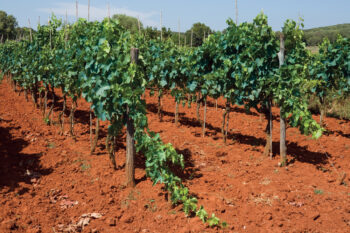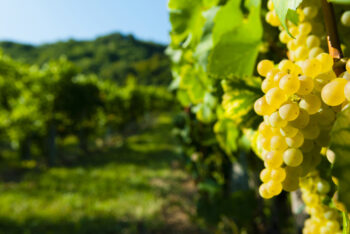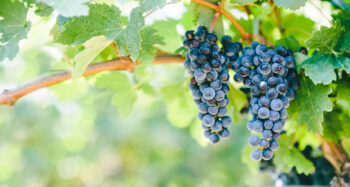

Croatia is a paradise for wine enthusiasts. Its breathtaking backdrop sets the stage for an exquisite wine-tasting experience, with numerous wineries and vineyards to explore. Beyond the extraordinary Croatian wine-tasting opportunities, you can engage in conversations with winemakers who share the tales behind their wines as they pour or even join home-hosted visits where you can assist in preparing a multi-course feast perfectly complemented by local wines.
Despite the somewhat challenging-to-pronounce names, many people outside of this enchanting region are unfamiliar with Croatian wines. However, once you savor them, you will likely crave more. Familiarizing yourself with Croatian wines, wine regions, and their offerings before your journey will allow you to fully savor your time in this captivating destination. Živjeli! (Cheers!)

Three primary wine regions make the Croatia’s wine landscape. Each of these is subdivided into subregions and vineyards-covered hillsides known as “vinogorje”. The most enticing regions for travelers are Istria, celebrated for its diverse range of orange and white wines; the Dalmatian coast, renowned for its bold and rich red wines with a hint of spice; and the Continental Hinterland in the northeastern part of the country, a bastion for exceptional white wines.
As one of the historic Croatian wine regions, Istria stands as the northernmost wine-producing area in Croatia. It encompasses the majority of the Istrian Peninsula, including a portion of southwestern Slovenia. Landscapes are reminiscent of Tuscany, featuring rolling vineyard-covered hills and medieval hilltop villages.
This region has achieved both domestic and international acclaim for its fruity, dry white wines, including the distinctive orange wines! These wines are typically crafted from various light-skinned Malvasia grape varieties. Istria has adopted New World styles emphasizing its aromatic, refreshing, crisp, and fruit-forward qualities.
Situated in the far southern reaches of the country, the Dalmatian Coast wine region encompasses areas like the Peljesac Peninsula, Vis Island, and Hvar. All of these places have a rich history of viticulture spanning centuries. Notably, the UNESCO-listed Stari Grad Plain on Hvar boasts the world’s oldest continuously cultivated vineyards. This region predominantly cultivates native grape varieties, encompassing both reds and whites. The result is the production of high-quality and internationally acclaimed wines. Discover this amazing area whenever you get the chance.
In the northeastern part of Croatia, grape cultivation and winemaking have a deep-rooted history dating back to pre-Roman times. This region stretches from Sibenik to Split and extends eastward toward Bosnia and Herzegovina. White croatian wines are the predominant style here, with vineyards surrounding towns such as Vrgorac, Sinj, Drnis, Knin, Imotski, and Vrlika, where shepherds have a longstanding presence.

Malvazija is among the most popular Croatian wines, predominantly cultivated in the Istria region. It stands as one of the oldest grape varieties in this area, with a history dating back to ancient Greek times, and was even documented in writing in as early as 1385. One hundred percent Istrian Malvazija is a wine of exceptional density and a recognizable amber color with a crystal shine. The smell exudes ripe fruitiness, and of the aromas, the smell of ripe apricots stands out the most, followed by melon and peach in shades. It has moderate acidity, rounded and harmonious wine. It goes great with vegetable appetizers and pasta with cheese- and cream-based sauces, risotto with seafood, as well as with boiled or baked fish and red meat.
Known worldwide by names like Welschriesling, Italian Riesling, olasz rizling, or even grashica. Graševina is an international grape variety cultivated not only in numerous other countries in Central and Eastern Europe. It is predominantly cultivated in Kutjevo vineyards, as well as on the southern slopes of mount Papuk and Krndija. It also thrives in the southern regions of Croatia, including Konavle. One of the advantages of Graševina is its versatility, allowing winemakers to produce a wide range of wine styles. This versatility enables them to experiment with different wine profiles. As a result, you can find everything on the market, from fresh and mineral Graševina wines to complex late-harvest or even select harvest wines made from dried berries and ice wines, which offer sweet and aromatic predicate wines enjoyed as an aperitif or paired with desserts.
According to legend, pošip is a wild vine found by chance and is a hybrid of two other island sorts. The name of this grape variety is believed to be influenced by the elongated and pointed shape of its berries, reminiscent of the pointed tip of a farming tool called ‘šip’ in the local dialect. The wine is closely associated with Korčula, where it has been cultivated for generations.
Pošip is a dry wine with pronounced aromas such as dried apricots and figs. It is golden yellow in color and has between 12 and 13 percent alcohol. Wines produced from pošip have a characteristic smell, high acidity and are excellent wines for preservation and aging. Hailing from both Mljet and Korčula islands, Pošip is a refreshing and fruity white wine. Accordingly, it pairs exquisitely with the region’s fresh catch of fish and seafood or serves as an excellent accompaniment to a variety of cheeses.
The grapes of this wine variety ripen late, benefiting from the lingering warmth of early autumn, which allows them to accumulate sugars in the berries and develop acidity. Wines crafted from Debit grapes are known for their balance and potable nature. It is produced from yellow grapes in the Dalmatian Coast region and is characterized by its citrusy and herbal notes. Debit is also highly regarded for its suitability in producing sparkling wines. Typically, Debit is used to produce dry wines with a gentle acidity, resulting in a light and lively character. Furthermore, this grape variety shows promising potential for crafting dessert wines. Debit wines generally exhibit an alcohol content of up to 12 percent. Displaying a golden-yellow hue, it is a versatile wine that pairs harmoniously with dishes such as young lamb, poached white fish, grilled prawns and shrimp. It also complements chicken breast dishes exceptionally well.
Traminac is a grape variety believed to have originated in Italy and the Tyrolean Alps, specifically the village of Tramin in the South Tyrol region. It is commonly divided into two main variations. Red Traminac, named for the characteristic color of its berries, yields moderately strong, golden-yellow wines falling into the semi-dry to semi-sweet category. On the other hand, Fragrant Traminac, known for its intense aroma of roses, gives rise to wines falling into the semi-sweet or sweet wine category. Traminac pairs exceptionally well with cheeses that feature noble molds, and complements river fish like catfish and carp, as well as fisherman’s stew and crayfish. Wines made from this grape variety are also recommended for spicy dishes and are best enjoyed when served well-chilled.

The deep blue-black grapes of Plavac Mali are densely clustered and firm, featuring thick skins and rich sugar content, resulting in consistently generous harvests. Plavac Mali wines typically possess an alcohol content ranging from 12 to 13.5 percent, and they are characterized by their robust, slightly bitter profile and a captivating deep purple hue. It’s worth noting that Plavac Mali wine earned the distinction of being the first Croatian red wine to receive protected geographical origin status back in 1961, a testament to its quality and heritage.
Plavac Mali takes center stage as the primary red grape variety cultivated along the Dalmatian Coast. It produces wines infused with a rich tapestry of ripe cherry flavors and subtle spice notes. You will encounter it on nearly every menu in Croatia, where it harmonizes beautifully with local favorites like grilled seafood, lamb, beef, as well as prosciutto and aged cheeses. Have a visit and see for yourself!
Dingač is a robust red wine crafted from the Plavac Mali grape in the Pelješac Peninsula, situated within the Dalmatian Coast region. This high-quality wine, often reserved for special occasions, exhibits a range of hues from dark red to purple. Furthermore, the wine undergoes aging in oak barrels, a process that enhances its intricacy and enriches its flavor profile. Being a premium wine, it enjoys significant demand and is regarded as a prime selection among wine connoisseurs. Moreover, Dingač wines are renowned for their complexity and ability to age gracefully; the finest examples of Dingač can be stored for extended periods. Accordingly, it boasts a fruity profile, featuring notes of cherries, plums, and herbs. It marries exceptionally well with red meat and aged cheese, making it a standout choice among Croatia’s renowned wines.
A wine of deep ruby-red hue, Kaštelanski Crljenak embodies the essence of Dalmatia with its rustic charm and robust flavors. This wine boasts a commanding presence, characterized by a substantial body, marked tannins, and a generous alcohol content. A particular fun fact about it – it was established that it is the ancestor of the world-famous Zinfandel variety. However, what truly sets it apart is the delightful interplay of flavors that dance on the palate. Upon savoring Kaštela Crljenak, one can expect to be greeted by a medley of fruity notes, reminiscent of luscious red fruits. These flavors, punctuated by subtle hints of pepper and anise, create a harmonious and memorable tasting experience. Additionally, it pairs exceptionally well with hearty meats, such as beef and venison, enhancing the dining experience with its bold presence.
Mature Teran grapes are characterized by their nearly blackberry color with a firm skin that conceals red flesh. The wine produced from them has a distinctive ruby-red hue and a pronounced fruity aroma, particularly reminiscent of raspberries. A native grape originating in Istria, Teran yields a robust red wine celebrated for being aged in wooden casks. Teran’s versatility shines through when it comes to pairing with various dishes. It pairs beautifully with traditional Istrian prosciutto and an array of cheeses. For a fresh Teran, it harmonizes wonderfully with dishes like grilled small bluefish, skewered carp, pork dishes, and more. When you opt for aged Teran, it makes an outstanding companion for classics like lasagna or pasta dishes featuring tomato and meat sauce, such as bolognese.
Frankovka is a red grape variety that has been cultivated in Europe for centuries. It represents an approachable red wine with pleasant acidity. It is a grape variety that bears fruit notes well, which is why its popularity has been growing in recent years. In Croatia, it is most commonly found in continental regions. Slavonia, Moslavina, and Plešivica produce it, but it is also grown in Primorje and Istria. Among the Frankovka varieties cultivated in Croatia, iločka frankovka has received recognition as a premium wine. Initially, Frankovka produces fruitier, light, and lively wines, but as it matures, it gains elegance. It is distinguished by its ruby red color, and its taste is described as having fruity aromas of ripe cherry and blackberry.

Croatia’s wine culture is a captivating journey through ancient vineyards and distinctive traditions. From Istria’s aromatic landscapes to the Dalmatian Coast’s rich heritage and the Continental Hinterland’s historic roots, Croatia’s wine culture reflects the essence of the region. With a blend of tradition and modernity, it promises to shine on the global wine stage. That is a testament to the passion and artistry of its winemakers. While this blog highlights some of Croatia’s exceptional wines, it is important to note that there are countless more awaiting discovery, and we encourage you to keep your taste buds adventurous. As always, you can find out more about Croatian wines here. Cheers to the excellence of Croatian wine culture!